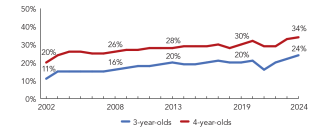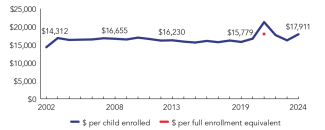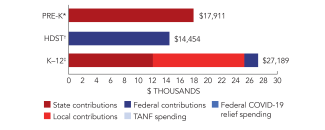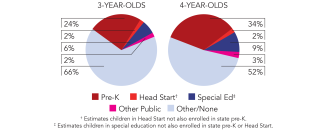
State of Preschool
New Jersey
Access Rankings
Resource Rankings
Total Benchmarks Met
Overview

During the 2023-2024 school year, New Jersey preschool enrolled 61,868 children, an increase of 3,481 from the prior year. State spending totaled $1,108,123,000, up $161,011,555 (17%), adjusted for inflation, since last year. State spending per child equaled $17,911 in 2023-2024, up $1,690 from 2022-2023, adjusted for inflation. New Jersey met 9 of 10 quality standards benchmarks.
What's New

For the second year, New Jersey is reporting only one state-funded preschool program. In an effort to move towards a universal program with common standards, the state is actively phasing out two long-standing programs (the Early Launch to Learning Initiative (ELLI) and Early Childhood Program Aid (ECPA)) and converting those seats to the higher standards required under the state’s largest program, which is now referred to as the Preschool Expansion Program.
In FY 2024, Governor Murphy and the legislature dedicated funding in the state budget for new districts to apply to serve children under the Preschool Expansion Program, and an additional 42 districts received funding to provide full-day preschool for 3- and 4-year-olds. The New Jersey Department of Education (NJDOE) released a funding opportunity for Regular Operating District (ROD) grants to school districts to assist with the cost of building or modifying classrooms to allow for additional preschool seats. At the same time, the New Jersey Economic Development Agency (NJEDA) released a funding opportunity to allow licensed child care centers to apply for funds to make renovations to buildings.
Background
New Jersey’s largest and most intensive program, formerly known as the Abbott Preschool Program, was originally established under a 1998 New Jersey Supreme Court mandate to serve all 3- and 4-year-olds in 31 of the state’s lowest income school districts. Since 2018, the state has expanded the program to include almost 300 school districts that are approved to expand their preschool programs to meet Abbott standards. The NJDOE funds these districts to provide a full-day program to resident 3- and 4-year olds, with the goal of growing to reach 90% of the preschool-age population. The original 31 Abbott districts are required to contract with licensed private child care centers or Head Start programs that meet state standards. All other districts are required to contract with willing and able Head Start agencies, and encouraged to contract with private child care.
As noted above, the state is in the process of phasing out the ECPA and ELLI programs, which now operate in less than a dozen school districts.
New Jersey State Overview
Access
Resources
| Total state pre-K spending | $1,108,123,000 |
| Local match required? | No |
| State Head Start spending | $51,023,727 |
| State spending per child enrolled | $17,911 |
| All reported spending per child enrolled* | $17,911 |

*Pre-K programs may receive additional funds from federal or local sources that are not included in this figure. †Head Start per-child spending includes funding only for 3- and 4-year-olds. ‡K–12 expenditures include capital spending as well as current operating expenditures.
New Jersey Quality Standards Checklist
| Policy | Requirement | Benchmark | Meets Benchmark? |
|---|---|---|---|
For more information about the benchmarks, see the Executive Summary and the Roadmap to State pages. | 9benchmarks met | ||
| Early Learning & Development Standards Benchmark | Comprehensive, aligned, supported, culturally sensitive | Comprehensive, aligned, supported, culturally sensitive | |
| Curriculum Supports Benchmark | Approval process & supports | Approval process & supports | |
| Teacher Degree Benchmark | BA | BA | |
| Teacher Specialized Training Benchmark | ECE | Specializing in pre-K | |
| Assistant Teacher Degree Benchmark | HSD | CDA or equivalent | |
| Staff Professional Development Benchmark | 100 hours/5 years; PD plans; Coaching | For teachers & assistants: At least 15 hours/year; individual PD plans; coaching | |
| Maximum Class Size Benchmark | 15 (Abbott/Expansion); 18 (ECPA); 20 (ELLI) | 20 or lower | |
| Staff to Child Ratio Benchmark | 2:15 (Abbott/Expansion); 1:9 (ECPA); 1:10 (ELLI) | 1:10 or better | |
| Screening & Referral Benchmark | Vision, hearing, health & more | Vision, hearing & health screenings; & referral | |
| Continuous Quality Improvement System Benchmark | Structured classroom observations; Data used for program improvement | Structured classroom observations; data used for program improvement | |
